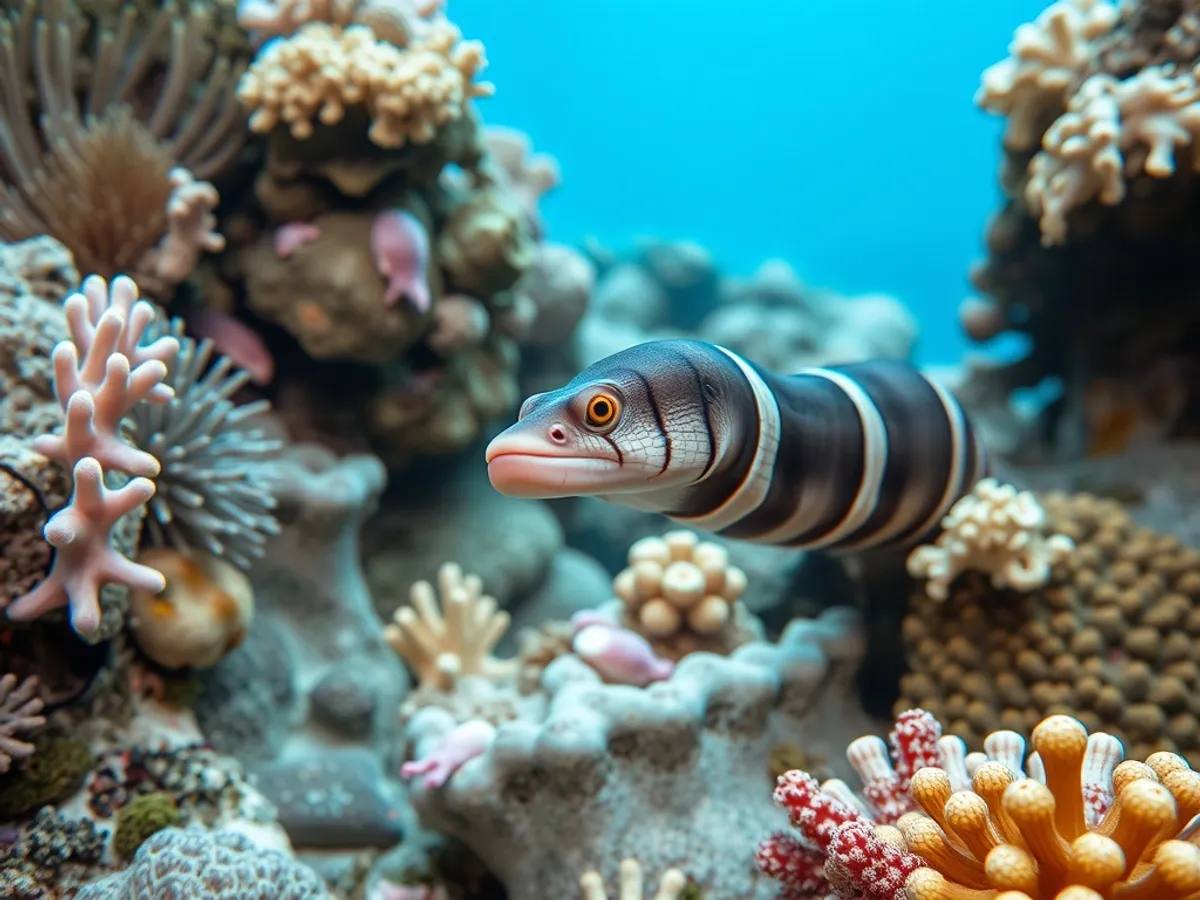
Ribbon Eel
Rhinomuraena quaesita

Meet the Ribbon Eel
The ribbon eel is a strikingly colorful species of moray eel notable for its long, slender body and ribbon-like dorsal fin. Native to Indo-Pacific coral reefs, it undergoes remarkable color and sex changes throughout its life, starting as black juveniles and turning blue as adult males, then yellow as they become females. Ribbon eels are secretive, often seen with just their heads poking out from crevices in the reef. They use their wide, flaring nostrils to detect prey, feeding mainly on small fish and crustaceans. Despite their dramatic appearance, ribbon eels are non-aggressive and pose little threat to humans.
Classification
Fish
Habitat
Coral reefs
Diet
Carnivore
Lifespan
10-20 years
Conservation
Least Concern
Weight
0.5-1.0 kg
📖Fascinating Facts
Colorful Transformations
Ribbon eels change color as they mature: juveniles are black with a yellow dorsal fin, adult males are bright blue with yellow accents, and females are entirely yellow.
Unique Nostrils
Ribbon eels have highly elongated, leaf-like nostrils that help them detect prey hidden in the reef.
Sex Change Experts
They are protandric hermaphrodites, meaning they start life as males and can change to females once mature.
📋Detailed Description
The ribbon eel (Rhinomuraena quaesita) is a visually striking moray eel distinguished by its elongated, ribbon-like body, which can reach lengths of up to 130 cm, though most individuals are smaller. Its most notable anatomical feature is the pair of highly elaborate, leaf-shaped anterior nostrils, which aid in detecting prey through chemoreception. The species exhibits dramatic ontogenetic color changes: juveniles are jet black with a yellow dorsal fin, adult males develop a vibrant electric blue body with yellow accents, and mature females become entirely yellow. Ribbon eels possess a continuous dorsal fin running the length of the body and lack pelvic and pectoral fins, typical of morays. Their jaws are narrow and elongated, equipped with sharp, backward-pointing teeth suited for grasping slippery prey. Ribbon eels are primarily solitary and highly secretive, spending most of their lives concealed in burrows within sandy or rubble substrates of coral reefs, with only their heads exposed. They are known for their rhythmic, undulating swimming when moving between burrows. Unlike many morays, ribbon eels are not aggressive and rarely bite unless provoked. Their unique life history includes sequential hermaphroditism, with all individuals maturing first as males and later transitioning to females, a rare trait among moray eels.
💡 Did you know?
All ribbon eels are born male, but can transform into females later in life—a rare phenomenon known as sequential hermaphroditism.
🔬Research & Sources
Wikipedia Summary
The ribbon eel, also known as the leaf-nosed moray eel or bernis eel, is a species of moray eel, the only member of the genus Rhinomuraena. The ribbon eel is found in sand burrows and reefs in the Indo-Pacific Ocean. Although generally placed in the moray eel family Muraenidae, it has several distinctive features leading some to place it in its own family, Rhinomuraenidae.
Last Modified: 6/9/2025
🎭Behavior & Social Structure
Ribbon eels are ambush predators, remaining motionless with their heads protruding from burrow entrances, waiting for unsuspecting prey to pass by. They rely heavily on their acute sense of smell, facilitated by their flared nostrils, to detect small fish and occasionally crustaceans. When prey is within range, they strike with lightning speed, using their sharp teeth to seize and swallow prey whole. Ribbon eels are diurnal but may exhibit crepuscular activity, emerging more frequently at dawn and dusk when prey is abundant. Social interactions are minimal; individuals are territorial and maintain exclusive burrows, though in rare cases, overlapping territories have been observed. They are known to exhibit site fidelity, often occupying the same burrow for extended periods. Ribbon eels may occasionally leave their burrow to search for new shelter or during reproductive periods.
👶Reproduction & Life Cycle
Ribbon eels are protandric hermaphrodites, meaning individuals first mature as functional males and later transition to females. The exact triggers for sex change are not fully understood but may involve social or environmental cues. Spawning is believed to occur year-round in tropical waters, with peaks during warmer months. During courtship, males and females engage in synchronized swimming and body contact near the entrance of their burrows. Fertilization is external; females release eggs into the water column, which are then fertilized by the male. The eggs are pelagic and hatch into leptocephalus larvae, which drift with plankton for several months before settling onto the reef and metamorphosing into juvenile eels. There is no parental care after spawning. The transition from male to female is thought to occur after several years, with the female phase being relatively brief compared to the male phase.
🛡️Adaptations & Survival
Ribbon eels possess several unique adaptations for their reef-dwelling lifestyle. Their elongated, flexible bodies allow them to navigate narrow crevices and burrows, providing protection from predators. The highly developed anterior nostrils enhance olfactory sensitivity, crucial for detecting prey in low-visibility environments. Their cryptic coloration at different life stages provides camouflage: black juveniles blend with shadows, while blue and yellow adults may mimic toxic reef organisms. The ability to change sex (sequential hermaphroditism) increases reproductive success in sparse populations. Their jaws are adapted for rapid extension and retraction, enabling swift prey capture. Ribbon eels also exhibit remarkable regenerative abilities, healing minor injuries quickly, which is advantageous in the abrasive reef environment.
🎨Cultural Significance
Ribbon eels are popular in the marine aquarium trade due to their striking appearance, though they are challenging to keep and rarely survive long in captivity. In some Indo-Pacific cultures, moray eels in general are regarded with a mixture of reverence and superstition, sometimes associated with ancestral spirits or used in traditional medicine, although there are no specific myths or uses documented for ribbon eels. Their unique appearance has made them a subject of fascination among divers and underwater photographers, contributing to ecotourism in reef regions.
🔬Recent Research & Discoveries
Recent research has focused on the ribbon eel's unique reproductive biology, particularly its sequential hermaphroditism, which is rare among moray eels and of interest to evolutionary biologists. Studies using molecular phylogenetics have confirmed its distinctiveness within the Muraenidae, though some taxonomists propose placing it in its own family, Rhinomuraenidae, due to its unique morphology. Ongoing research includes population genetics, larval dispersal patterns, and the impact of aquarium trade collection on wild populations. Observational studies have also documented their site fidelity and burrow construction behavior. Advances in underwater videography have provided new insights into their feeding and social behaviors.
🎥Wildlife Videos

Ribbon eel Description, Characteristics and Facts!
Hi, this is animal planet tv channel. Ribbon eel Description, Characteristics and Facts! my channale name animal planet tv .
animal planet tv

Moray Eels are Straight out of Alien
----------- SOCIAL MEDIA https://www.instagram.com/animalogicshow/ https://twitter.com/animalogicshow ...
Animalogic

The Ribbon Eel - Animal of the Week
This week we're looking at a very colourful kind of eel - the Ribbon Eel. Join our Discord server: https://discord.gg/jTsGYtRBHZ ...
Ben G Thomas

The Fascinating Life of the Electric Ribbon Eel
Nature

1 Minute Animals: The Blue Ribbon Eel - A Color-Changing Ocean Wonder
ribboneel #animals #oceananimals #seaanimals #eel Dive into the mesmerizing world of ribbon eels with this 1-minute video!
Wildlife by Aanvi

All ribbon eels are born male #eels #truefacts #animals
Now ribbon eels are a type of Mor eel that also like to spend most of their lives in Holes the ribbon eel's anus is about 2/3 the way ...
Ze Frank
🌍Habitat Information
The Ribbon Eel typically inhabits Coral reefs environments. Ribbon Eels have adapted to their environments with specialized features and behaviors.
Primary Habitat:
Coral reefs
More detailed habitat information will be available soon.
🛡️Conservation Status
The Ribbon Eel is currently classified as Least Concern. Conservation efforts are crucial for preserving this species for future generations.
Common Threats:
- 🏠Habitat loss and fragmentation
- 🌡️Climate change impacts
- 🎯Hunting and poaching
- 🏭Human-wildlife conflict
⚠️Threats & Conservation Challenges
Currently assessed as Least Concern by the IUCN, ribbon eels face localized threats from habitat degradation, particularly coral reef destruction due to coastal development, pollution, and climate change. Collection for the aquarium trade poses an additional threat, as ribbon eels often fare poorly in captivity due to their specialized dietary and habitat needs, leading to high mortality rates. Overfishing is not a significant threat, as they are not targeted for food. Population trends are not well-documented, but the species' wide distribution and adaptability to various reef habitats provide some resilience. Conservation challenges include enforcing sustainable collection practices and protecting critical reef habitats.
🔬Scientific Classification
Scientific Name
Rhinomuraena quaesita
Classification Hierarchy
🔍 About Taxonomic Classification
Taxonomic classification is a hierarchical system used by scientists to classify and organize living organisms based on shared characteristics and evolutionary relationships.
The system moves from broad categories (Kingdom) to increasingly specific ones, with each animal's scientific name typically consisting of its Genus and species.
📝Community Notes
Share your observations and insights about the Ribbon Eel with our community of wildlife enthusiasts.
Join Our Community
Sign in to share your observations and connect with fellow wildlife enthusiasts.
Sign In to ContributeNo community notes yet
Be the first to share your observations about the Ribbon Eel!
Explore Ribbon Eel
Select a tab above to learn more about this amazing animal.
📸Photo Gallery
No photos available for this animal yet.
🌟Discover More Wildlife
Continue your journey of discovery with more fascinating animals from our database
